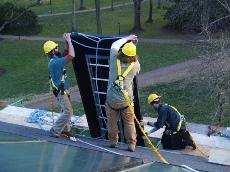Most people at Guilford know about the school’s commitment to environmental sustainability, as indicated by the recent installation of 12 solar panels on the roof of Shore Hall. However, most people do not know that the majority of environmental projects have been largely student-driven. “Students here have been responsible for many environmental changes here on campus,” said Kim Yarbray, environmental sustainability coordinator. “It’s great to see students learn things in the classroom and then apply them to real-life situations.”
For example, the Shore solar panel development was implemented by the sustainability council, which has a large amount of student representation.
While the council has been responsible for many campus sustainability projects, several ideas for campus improvements have come from classes in the environmental studies department.
The department stresses the importance of “hands-on” learning and interdisciplinary approaches to problems. According to the department Web site, http://www.guilford.edu/envst, classes focus on “experiential learning (as) a vital part of (their) program.”
Every fall semester, the Introduction to Environmental Studies course (ENVS101) requires that the students establish a project that promotes sustainability on campus.
Examples of some of the projects produced by environmental studies classes are the installation of waterless urinals, construction of a bio-retention cell by the South Apartments and the use of environmentally friendly cleaners in campus bathrooms.
“These student-led projects exhibit the ability of students to create visible change,” Yarbray said. “Working on changing problems with the campus is a lot more valuable to (students’) education than saving another paper on their hard drive.”
The emergence of other student-run organizations, such as the Greenleaf Coffee Co-operative, the organic garden and the veggie co-operative, illustrate the influence students have on campus.
This year, senior Carl Simon implemented the Green Fund, which, according to its proposal, will “continue (a) movement towards sustainability and true stewardship with respect to the environment.” The fund is now on the Case Statement, which is a list of funding goals for the upcoming capital campaign.
Formed by alumni donations, the endowment will provide money for campus initiatives such as preservation of the lakes and woods, green-building investments, alternative energy, enhancement of the recycling program and carbon neutrality.
“Throughout the process it was clear to me that, because I was a student, administrators were more willing to listen,” Simon said. “Jon Varnell, vice president of facilities said to me, ‘It is just so cool that this (idea) came from a student.'”
Once enacted, the Green Fund will secure Guilford’s commitment to sustainability. The fund will be monitored by the environmental studies program coordinators, the facilities department, and the sustainability council. The project will continue the collaboration among faculty, students and administration.
“It has been overwhelmingly clear to me that students have the power to create change on campus,” Simon said. “Administrators are probably sick of talking to each other and it is refreshing for them to work with a student. We really do have the opportunity to make a difference here.

